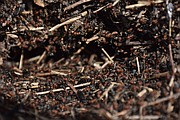Thatching ant hills only a portion of the nest
Anyone who’s walked through the pine forests of Boundary County has seen them, the large, often knee high mounds of pine needles and other forest debris, which, on a sunny day, are swarming with ants. These are the homes of thatching ants. In bad weather these appear to be lifeless piles of debris, but on sunny days they can be boiling with activity. Thatching ant colonies are abundant, especially in Jack Pine forests wherever there is a site that receives good sunshine. The edges of roads and snowmobile trails are great spots to find them. Warmth from the sun is an important resource for the developing eggs and larvae.
If you watch an active colony closely for any length of time you will witness the ants bringing in, not only more building materials, but food, in the form of caterpillars, and various other insects or parts thereof. It’s not uncommon to see several ants struggling with some still-alive prey item being dragged to its doom down the tunnels that lead below ground.
Thatching ants, of the Genus, Formica, are large ants (for ants), about 0.10 -0.25 inches long in length. They are stocky ants (again, for ants) with large heads and powerful jaws. Most are bi-colored, red and black, but some species are all black. It’s usually the head end that is red. They are polymorphic; that is, within one colony there may be workers of different size and shape.
The large mound created by the ants is more often noticed than the ants themselves. Thatching ant mounds may be 3 to 4 and a half feet across and 3 feet high! The mound really only represents part of the entire nest structure. Much of the colony’s home is a vast array of subterranean tunnels. Thatching ants derive their common name from their habit of creating large mounds, which appear to be “thatched” as they have materials layered on top like a thatched roof.
A thatching ant colony is initiated by one mated queen. She finds a suitable location, digs some tunnels and lays eggs, then rears the first batch of young to maturity. These workers, all females, then begin to care for the queen as she focuses on egg-laying. And they take over the nest building and hauling food back for the colony. Colonies may persist for up to 20 years and can contain many thousands of individuals. In late summer, thatching ant colonies produce their reproductive forms, the winged males and females “flying ants”. The females (new queens) and males (drones) fly away from the colony. They mate, shortly afterward the males will die, their role in the life cycle completed. The inseminated queens build new nests and start new colonies.
Ants, in general, get a bad rap for invading our homes and ruining picnics, but they are some of the most beneficial insects. They catch and eat huge quantities of other insect pests. They also scavenge, feeding on the remains of larger dead animals, helping to clean up the planet. Their burrowing, for nest construction, helps aerate soils and promotes water absorption into the landscape. Ants are one of the most important soil-building animals.
Ants, in turn, are food for many other critters, including in some cases very large critters, like bears. If you’ve ever walked in the woods and seen ant mounds with great holes in the middle, or the whole mound ripped apart, that’s bear damage. Bears love the eggs and larvae that a large colony can produce. The ants move their eggs and larvae up into the raised warmer sections of their nest to speed development, which puts them at risk from marauding bears.
In winter, the ants in a colony go down deeper into the below-ground tunnels of the nest and remain below the frost-line until spring. Several species of small snakes and the young of larger snakes are known to use ant nests as overwintering refuges, too. How they manage to co-exist with the ants all winter is a wonder.
Trust me, if you do evoke the wrath of an entire colony of thatching ants, you won’t hang around for long. Whenever you’re watching these large red and black ants, be careful, they bite!



